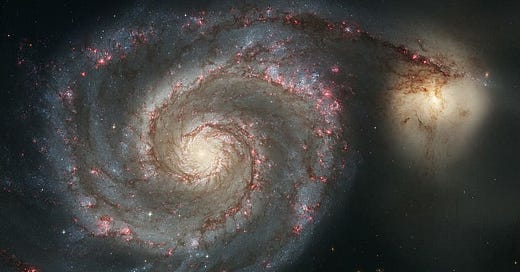Do you know what happens when two galaxies smash into each other at a typical collision speed of nearly one million miles per hour?
Surprisingly little, actually. At least at first. In the words of my graduate dynamics textbook, they "simply pass through one another like ghosts." Gotta love a good dynamics ghost.
The reason for this is actually pretty straightforward: galaxies are mostly empty space. If you were to shrink the sun to the size of a basketball in Chicago, the nearest star to it would be on the other side of the planet, somewhere in Hawaii. Now what are the odds of hitting another basketball thrown randomly from outer space? Very much not good. The balls will basically never collide. So too with a galaxy - the stars pass each other like ships on opposite sides of the planet, alone and distant in the night.
But that’s not the end of the story. Because these passing stars, as if of their own accord, all slow down. Which is its own sort of surprise. On earth we slow down because of contact: our sled grates along the ground or our parachute catches the wind - trillions upon trillions of molecules pushing back on our bodies, staying our fall. But in space their’s no contact, no appreciable density of particles to slow the fall. The closest stellar pass might be trillions of miles, that is to say light years, away. And yet, the stars slow down. Over long periods of time they slow dramatically, altering the course of their orbits, eventually bringing galaxies back together again to settle: derailed and stopped. Effectively braked. So, the question for today: why does that happen? How do you pump the brakes in space? What allows galaxies to come together, and then pause, and stay a while?
Allow me to introduce you to the fascinating, if confusing, advanced astrophysical idea of dynamical friction. Dynamical friction - a special process that slows the stars of colliding galaxies – the stickiness that makes galaxies come back to each other, like lassoed bulls or uncertain lovers. Don’t let its name fool you: it’s very different from regular friction, which makes sleds stop and gears grind: though dynamical friction has a similar slackening effect, it requires no contact, no roughness of surfaces, no sliding or squealing or great carpet burns. It’s a slowing force that arises not from any ground, but instead from the motions (that is, the dynamics) of the surrounding stars.
Here’s the idea: an object, like a star, black hole, or star cluster from galaxy #1, passes through the spaced out stars in galaxy #2. The stars in galaxy #2 are gravitationally attracted toward the object - stars above it move down toward it, and stars below it move up toward it. This means that after it passes, there’s a higher density of stars behind the object - a crowd of stars in its wake (see Figure 1).
But here’s the thing about dynamical friction - it’s impossible for the object not to be affected by the crowd behind it. The large number of stars directly behind the object exert a gravitational tug on the object that pull on it from behind, slowing it down. Said again, the pull from the higher density crowd is larger than the collective pull from any of the other stars; the crowd pulls back on the object, affecting its motion, slowing it down.
I wonder the extent to which people also suffer from dynamical friction. I think I certainly do…
TO BE CONTINUED on Friday, August 18… (pardon the cliffhanger, but the second part is still taking shape! Suffering from its own dynamical friction, if you will…)






I wonder if our memories form a sort of dynamical friction as we pass through life and this is the pull we feel to go back, reflect and get nostalgic for the past.
Memories are weird. We like to think of them as factual and carved in stone, but they are actually very dynamic. They get pruned and reshaped and recast. Perhaps this is why we can get nostalgic for periods of life that were, at the time, actually experienced as quite humdrum or even stressful. Our brains prune out all the "space" in between, leaving a denser cluster of memories that pulls us backwards.